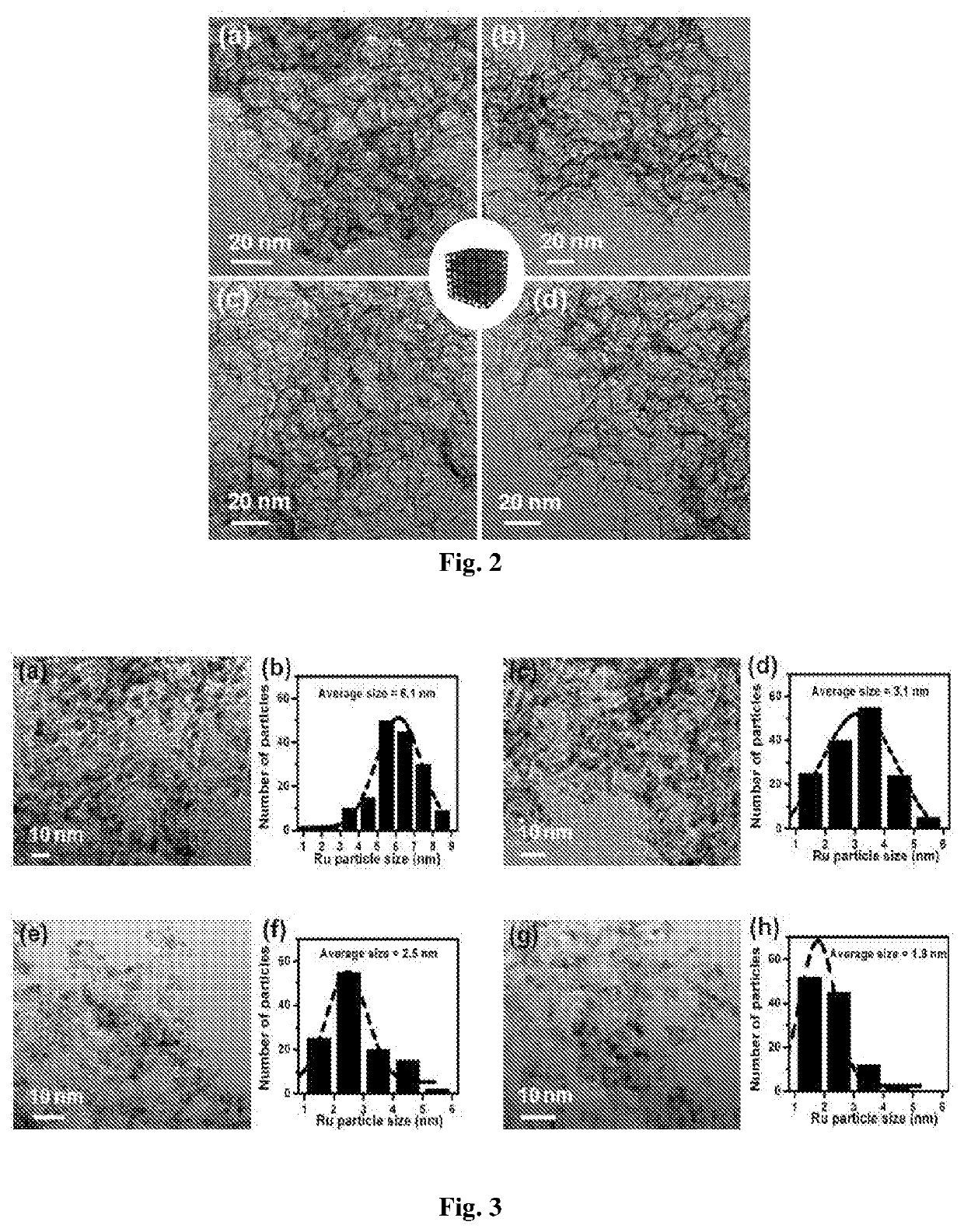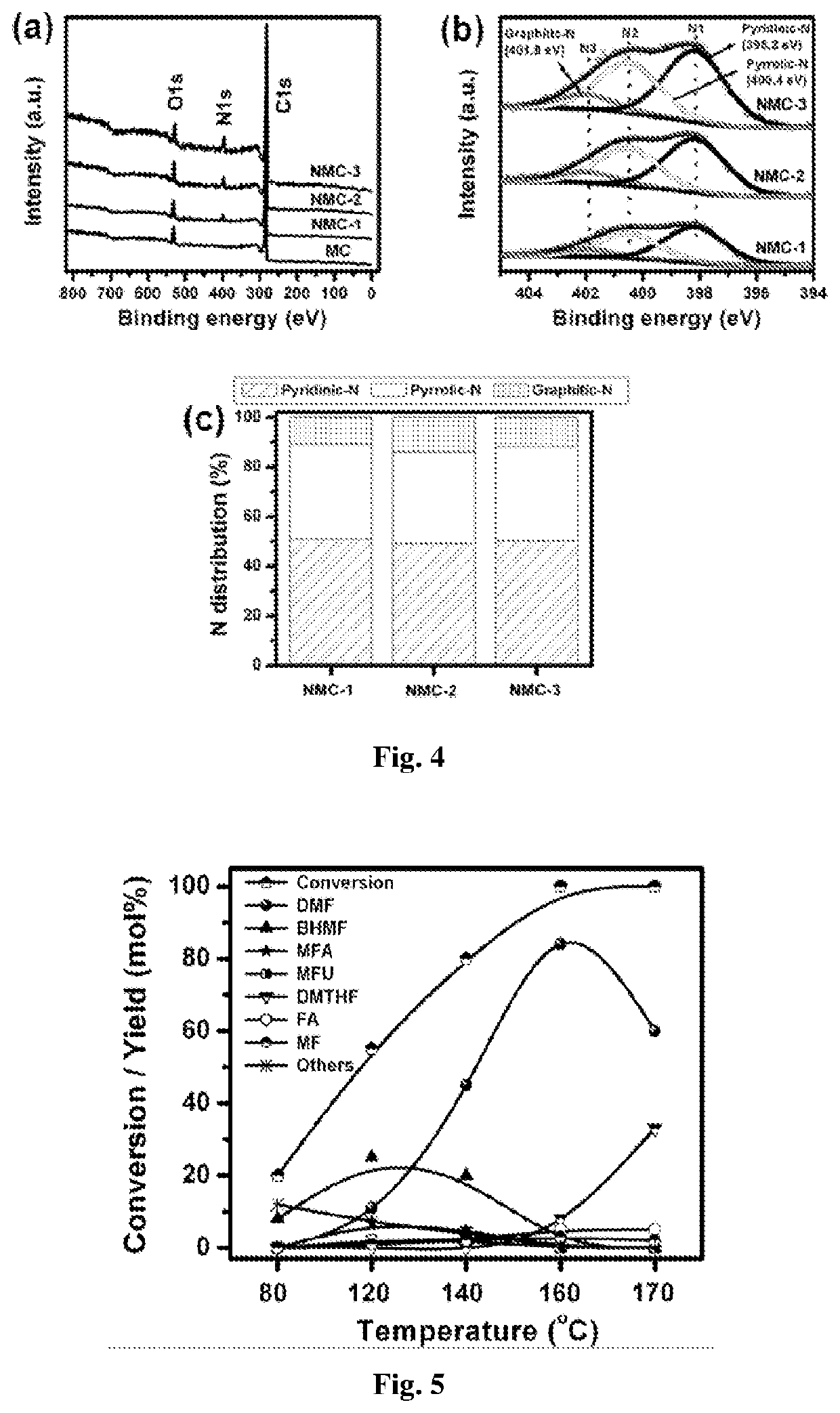Transition metal(s) catalyst supported on nitrogen-doped mesoporous carbon and its use in catalytic transfer hydrogenation reactions
a transition metal and catalyst technology, applied in the direction of catalyst activation/preparation, metal/metal-oxide/metal-hydroxide catalyst, physical/chemical process catalyst, etc., can solve the problems of difficult commercialization, acid use is not environment friendly, and dmf consumes only one-third of the energy for separation by distillation, etc., to achieve high dispersion
- Summary
- Abstract
- Description
- Claims
- Application Information
AI Technical Summary
Benefits of technology
Problems solved by technology
Method used
Image
Examples
example 1
of Nitrogen-Doped Mesoporous Carbons (NMC)
[0077]The NMCs were prepared by colloidal silica assisted sol-gel process, using melamine as a nitrogen source. In a typical synthetic procedure, 3.67 g of phenol (39 mmol) and 6.33 g of formaldehyde (78 mmol) were added drop-wise to 50 mL of NaOH solution (0.2 M, 10 mmol) under stirring. This mixture was stirred at room temperature for 20 min and then heated in an oil bath at 70° C. while stirring, for 40 minutes. About 4.92 g of melamine (39 mmol) and another part of formaldehyde (9.5 g, 107 mmol) were then added to the above solution with continuous stirring for 30 min. This was followed by the addition of 50 g of Ludox SM-30 sol (30 wt % SiO2) with stirring for 1 h. The suspension was then transferred to sealed bottle and heated at 80° C. for 3 days. The obtained gels were dried at 80° C. and powdered using mortar-pestle. The material obtained was carbonized in nitrogen flow at 800° C. for 3 h while raising the temperature at a heating r...
example 2
of Ru-NMC
[0078]The catalyst 2 wt % Ru-NMC was synthesized by modified ultrasonic-assisted method. Typically, 0.1 g of NMC was dispersed in 50 mL of deionized water in a 100 mL round bottom flask by ultrasonication (20 min). To it, 0.5 mL of aqueous solution of RuCl3 (Ru content 4 mg / mL) was added under agitation in ultrasonicator. This mixture was stirred at 80° C. for 6 h and cooled to room temperature. Then, aqueous solution of NaBH4 (Ru / NaBH4=1:4 mol mol−1) was added to it slowly under ultrasonication (30 min). The solution was filtered and washed with deionized water. The resulting 2 wt % Ru-NMC catalyst was dried at 80° C. for 10 h and used as catalyst for hydrogenolysis reactions. Catalyst samples with different Ru loadings (0.5, 1 and 5 wt %) were prepared using a similar procedure by taking appropriate amounts of RuCl3. Catalysts 2 wt % Ru-MC, 2 wt % Ru-AC (AC-activated carbon), 2 wt % Pd-NMC, 2 wt % Pt-NMC, 2 wt % Rh-NMC, 5 wt % Ni-NMC, 5 wt % Cu-NMC and 2 wt % Au-NMC were ...
example 3
[0079]All the reactions were carried out using 100 mL Parr autoclave (SS316). In a typical experiment, the reactor was charged with 1 mmol HMF (or 5 mmol furfural), hydrogen donor (25 mL), n-decane (0.2 g, internal standard) and required amount of freshly prepared catalyst. The reactor contents were mixed thoroughly and the reactor was sealed, purged 2-3 times with N2 and pressurized to 20 bar N2 pressure. Subsequently, the reaction vessel was heated under stirring at required temperature for a desired duration. Liquid samples were withdrawn periodically during the reaction and analyzed by GC (Agilent 7890A) equipped with a flame ionization detector (FID) having CP Sil 8CB capillary column (30 m length, 0.25 mm diameter). Product identification was done using authentic standards and GC-MS (Varian, Saturn 2200) analysis.
PUM
| Property | Measurement | Unit |
|---|---|---|
| Temperature | aaaaa | aaaaa |
| Temperature | aaaaa | aaaaa |
| Temperature | aaaaa | aaaaa |
Abstract
Description
Claims
Application Information
 Login to View More
Login to View More - R&D
- Intellectual Property
- Life Sciences
- Materials
- Tech Scout
- Unparalleled Data Quality
- Higher Quality Content
- 60% Fewer Hallucinations
Browse by: Latest US Patents, China's latest patents, Technical Efficacy Thesaurus, Application Domain, Technology Topic, Popular Technical Reports.
© 2025 PatSnap. All rights reserved.Legal|Privacy policy|Modern Slavery Act Transparency Statement|Sitemap|About US| Contact US: help@patsnap.com



